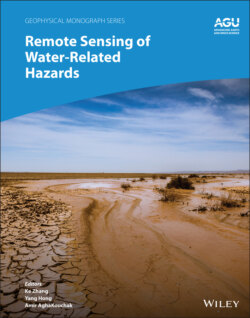Читать книгу Remote Sensing of Water-Related Hazards - Группа авторов - Страница 13
1.1. BACKGROUND
ОглавлениеWater‐related hazards broadly include floods, droughts, rainfall‐triggered landslides, water‐scarcity‐induced soil salinization, and many other interconnected hazards related to water. Floods and droughts, as the core types of water‐related hazards, have caused numerous losses of human lives and properties throughout human history (Du et al., 2018; Paprotny et al., 2018). With rapid socioeconomic development, population and industrial growth, and other anthropogenic activities over recent decades, many new water‐related challenges have emerged and imposed increasing threats on the built and natural environment (Lehnert et al., 2017; Wear et al., 2021; Zhang et al., 2021). Moreover, climate change and variability have altered regional to global water cycles (Huntington, 2010; Zhang et al., 2018; Y. Q. Zhang et al., 2016), causing an overall increase in the frequency and intensity of drought and floods around the world (AghaKouchak et al., 2015; Gu et al., 2020). Importantly, climate change is projected to increase the frequency and intensity of drought and floods in the mid‐ to late 21st century (IPCC, 2013; Wu et al., 2020), and to combine with other anthropogenic activities (AghaKouchak et al., 2021; Zhang et al., 2015; Y. Q. Zhang et al., 2016), leading to a rising risk to humans (Kam et al., 2021; Roudier et al., 2016). The growing impacts of water hazards have spurred research into improving monitoring and prediction of water hazards (Khaing et al., 2019; Makinano‐Santillan et al., 2019), understanding the underlying drivers (Gui et al., 2020), implementing various mitigation and adaptation strategies (Xu et al., 2020), and identifying other relevant factors such as climate change, population growth, exposure, and socioeconomic development.
Historically, water‐related hazards have been monitored and studied using ground‐based point observations or spatially interpolated grids (AghaKouchak et al., 2014; He et al., 2018; Sheffield et al., 2012). Globally, many areas are not well instrumented to provide sufficient ground‐based observations of precipitation, near‐surface air temperature, relative humidity, soil moisture, and atmospheric water vapor among other hydrometeorological variables that are necessary for monitoring and investigating the water‐related hazards (AghaKouchak et al., 2015). In addition, ground‐based gauges are often destroyed by water‐related hazards such as flash floods, hurricanes, and landslides, making real‐time observation and consistent analysis of water‐related hazards challenging.
Remote sensing refers to the process of detecting and monitoring an object at a distance from sensors, often onboard platforms such as aircrafts, satellites, unmanned aerial vehicles (UAVs), and towers. Satellite remote sensing of the Earth’s weather started in earnest with the Television and Infrared Observation Satellite (TIROS‐1) mission 1960 (NASA, 1987). TIROS‐1 became a very successful mission and led to a series of additional meteorological satellite missions such as the Nimbus series, the Environmental Science Services Administration Satellite Program (ESSA), the NOAA satellites, QuikScat, Landsat, and Tropical Rainfall Measuring Mission (TRMM). NASA launched the Earth Resources Technology Satellite, which was eventually renamed Landsat 1 in 1975, on 23 July 1972. The Landsat program is a joint NASA/USGS program that provides the longest continuous space‐based record of Earth’s land in existence. In 1997, NASA launched the Earth Observing System (EOS) program (https://eospso.nasa.gov) that is composed of a series of satellite missions and scientific instruments in Earth orbit, making it possible for long‐term global observations of the land surface, biosphere, atmosphere, and oceans. There are mainly two common types of Earth‐observing satellites, namely, geostationary satellites and sun‐synchronous polar‐orbiting satellites (Njoku, 2014). Geostationary satellites, at altitudes of approximately 36,000 kilometers, revolve at speeds that match the rotation of the Earth so they are stationary relative to the Earth’s surface (Njoku, 2014). This allows the satellites to observe and collect information continuously over specific areas, which are particularly valuable for monitoring weather and forecasting water‐related hazards (Njoku, 2014). In contrast, sun‐synchronous polar‐orbiting satellites are designed to follow a north‐south orbit, allowing them to cover most of the Earth’s surface over a certain period and collect data at the same local solar time, which are extremely valuable to observe the Earth’s surface to a larger extent and monitor changes over a long time period (Njoku, 2014).
The emergence of remote sensing techniques has provided new avenues to study, monitor, and predict water‐related hazards (AghaKouchak et al., 2015; Andreas et al., 2020; Argaz et al., 2019; Boni et al., 2020; Elsadek et al., 2019; Fu et al., 2009). Equipped with passive or active sensors in the optical, thermal, and/or microwave bands, remote sensing platforms can capture a wealth of information that can be used to measure and infer water‐related hazards and their impacts, including precipitation (Prabhakara et al., 1998; Sorooshian et al., 2000), evapotranspiration (Mu et al., 2007; Zhang et al., 2010), soil moisture (Du et al., 2016; Entekhabi et al., 2010; Kerr et al., 2012; Lindell and Long, 2016; Parinussa et al., 2015; Reichle et al., 2016; Wigneron et al., 2017), vegetation health (Jones et al., 2011; Mitchard et al., 2011; Zhang et al., 2008), total water storage (Schmidt et al., 2006; Tapley et al., 2004), snow cover (Ehrler et al., 1997; Zhou et al., 2014), inundation (Islam et al., 2010; Kumar et al., 2008), and land deformation (Guo et al., 2010; Rosi et al., 2018). As a result, remote sensing of water‐related hazards has become the cutting edge of the natural hazard studies.
